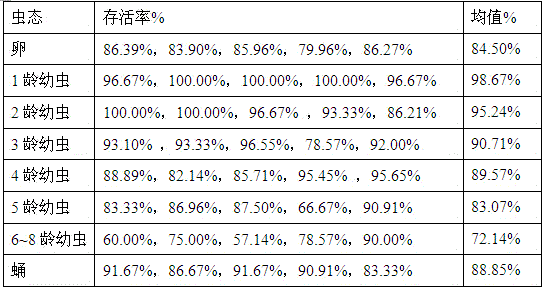The Method of Large Raising of Indoor Test Population of Coconut Weaver Moth
A coconut weaving moth, indoor test technology, applied in the direction of animal husbandry and other directions, can solve the problems of affecting the mating probability of female and male insects, the number of eggs produced by females, the small mating space of male and female adults, affecting the number of eggs laid by females, etc., so as to increase the number of females. The effect of spawning sites, increasing the number of male and female pairs, and increasing the area of the site
- Summary
- Abstract
- Description
- Claims
- Application Information
AI Technical Summary
Problems solved by technology
Method used
Image
Examples
Embodiment 1
[0027] S1. Rearing and Oviposition of Cocoa Weaver Moth Adults:
[0028] S11. Put 5 pairs of newly eclovened unmated males and females in a cylindrical transparent container (30 cm high, 25 cm in diameter).
[0029] S12. Cut the leaves of healthy coconut trees into 15cm lengths, put 10 pieces in each container, use cotton balls dipped in 10% honey water to supplement nutrition for the coconut weaver moth adults, and seal the container mouth with 200-mesh gauze.
[0030] S13. Replace the leaves every 3 days, and replace the cotton ball dipped in 10% honey water once a day. Honey prolongs the lifespan of the coconut weaver moth, and increases the amount of eggs laid and the survival rate;
[0031] S14. After 1-2 days, the coconut weaver moth begins to lay eggs, and the eggs are laid out on the surface of the leaves and the sealing gauze of the container. Every 3 days, the leaves and gauze with the eggs are picked out, and the same batch is put in the same batch. Put 1,000 eggs ...
PUM
 Login to View More
Login to View More Abstract
Description
Claims
Application Information
 Login to View More
Login to View More - R&D
- Intellectual Property
- Life Sciences
- Materials
- Tech Scout
- Unparalleled Data Quality
- Higher Quality Content
- 60% Fewer Hallucinations
Browse by: Latest US Patents, China's latest patents, Technical Efficacy Thesaurus, Application Domain, Technology Topic, Popular Technical Reports.
© 2025 PatSnap. All rights reserved.Legal|Privacy policy|Modern Slavery Act Transparency Statement|Sitemap|About US| Contact US: help@patsnap.com

